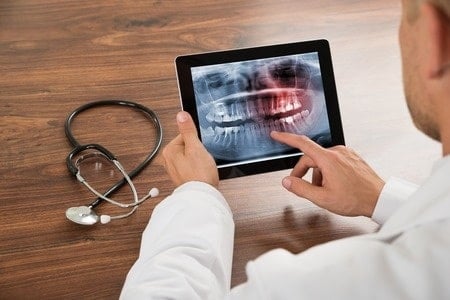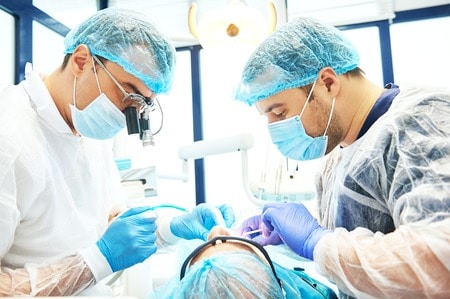Dental Implant Consultation
Common with most surgical procedures, a consultation will be required between the dentist and patient as a first step. During this time, the dentist will do several diagnostic tests to determine whether or not the patient has sufficient oral health to receive dental implants. These diagnostic tests will include an x-ray of the mouth so that the dentist can see how strong the surrounding bone structure is. If the x-ray shows that the jawbone density and dimensions can support dental implants, the only other preliminary procedure that may be required is a tooth extraction.
In some cases, however, the dentist may not be fully convinced with the x-ray results and will need to do a more advanced CT scan. This will give the dentist a much more detailed image of the surrounding jawbone structure allowing them to determine if any other preliminary procedures, like bone grafting or a sinus lift, may be required.
These diagnostic tests will include an x-ray of the mouth so that the dentist can see how strong the surrounding bone structure is. If the x-ray shows that the jawbone density and dimensions can support dental implants, the only other preliminary procedure that may be required is a tooth extraction.
In some cases, however, the dentist may not be fully convinced with the x-ray results and will need to do a more advanced CT scan. This will give the dentist a much more detailed image of the surrounding jawbone structure allowing them to determine if any other preliminary procedures, like bone grafting or a sinus lift, may be required.
Tooth Extractions
It may sound counter intuitive for tooth extractions to be requirement for dental implants, but it is actually a very common requirement. Several reasons that a patient may require a tooth extraction prior to receiving dental implants include:- the patient has a severely damaged or infected tooth which will be replaced with a dental implant, thus requiring the removal of the tooth in the first place.
- the patient requires multiple dental implants to replace several missing or damaged teeth. In this case, it may even be required to remove perfectly healthy teeth that will be in the way of the intended fixed dental bridge.
 The tooth extraction procedure can vary in intensity from patient to patient. In most cases it will be a simple tooth extraction procedure which can be accomplished by using forceps to pull the tooth out and some local anesthetic for the patients comfort. In less common scenarios where the tooth is severely damaged and cannot be simply pulled out with forceps, a surgical tooth extraction will be required.
The tooth extraction procedure can vary in intensity from patient to patient. In most cases it will be a simple tooth extraction procedure which can be accomplished by using forceps to pull the tooth out and some local anesthetic for the patients comfort. In less common scenarios where the tooth is severely damaged and cannot be simply pulled out with forceps, a surgical tooth extraction will be required.
Bone Grafting
When a tooth falls out, the surrounding jawbone structure begins to deteriorate slowly. As this happens, the bone density will become weaker, while the height and width of the jawbone become smaller. The longer this area goes without a tooth or dental implant, the more it will deteriorate. In cases where the width, height or density of the jawbone is not strong enough to support a dental implant, bone grafting will be necessary to build up the bone back to a sufficient level. This is a complicated procedure which requires using one of the following materials:- bone from the patients chin, shin or hip
- bone from a human or cow cadaver
- a synthetic bone like structure
 Using one of these bone or bone like materials, a dentist or periodontist will surgically place this a piece of it onto the area of the patients jawbone that requires strengthening. There will then be a healing period that can take up to 8 months for the new bone to fuse to the surrounding bone. Once it is completely healed, the jawbone will be ready to receive it’s dental implant with a much less likely risk of failure.
Using one of these bone or bone like materials, a dentist or periodontist will surgically place this a piece of it onto the area of the patients jawbone that requires strengthening. There will then be a healing period that can take up to 8 months for the new bone to fuse to the surrounding bone. Once it is completely healed, the jawbone will be ready to receive it’s dental implant with a much less likely risk of failure.
Sinus Lift
The sinus lift procedure is very similar to bone grafting, but is only a concern when placing dental implants to replace molars or premolars in the upper part of the mouth. When replacing these teeth, the dentist will have to examine that portion of the mouth to determine if any of the following circumstances are present:- the bone density in the back part of the upper jaw is not strong enough to support dental implants
- the patients sinus is larger than normal, causing it to be too close to the upper jaw